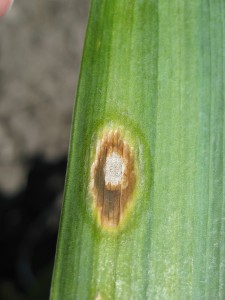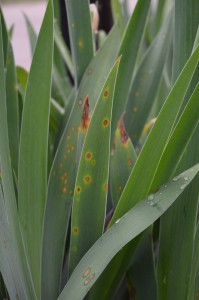(Bethany Grabow, KSU Plant Pathology)
Iris Leaf Spot is active and has been favored by the cool, wet weather conditions we are currently experiencing across much of Kansas. The spots are typically found on the leaves but can occur on the stalk and buds of the developing flower. The spots are dark with a reddish border and will appear water soaked followed by yellowing of the surrounding tissue.


As the disease progresses, the tips of the infected leaves will appear scorched. The disease will not kill the plant however it can reduce the plant vigor over time.

How can you protect your irises? The first step is to practice good sanitation by removing all the dead leaves prior to spring green up. The fungus that causes iris leaf spot overwinters on the dead leaves from the previous year, and removing those leaves will break the life cycle.
If you have a history of severe iris leaf spot and yearly sanitation alone is not effective, fungicides are available. Fungicides can be sprayed every 10 days for 4 to 6 weeks starting when new leaves emerge in spring. For more information on fungicide products and application for iris leaf spot go to http://www.hfrr.ksu.edu/doc1645.ashx. Be sure to follow the instructions on the fungicide label.

